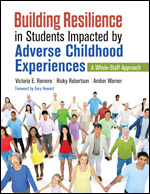Building Resilience in Students Impacted by Adverse Childhood Experiences
A Whole-Staff Approach
- Victoria E. Romero - Educational Consultant
- Ricky Robertson - Behavior Specialist
- Amber Warner - Social Worker
Foreword by Gary R. Howard
Use trauma-informed strategies to give students the skills and support they need to succeed in school and life
Nearly half of all children have been exposed to at least one adverse childhood experience (ACE), such as poverty, divorce, neglect, homelessness, substance abuse, domestic violence, or parent incarceration. These students often enter school with behaviors that don’t blend well with the typical school environment. How can a school community come together and work as a whole to establish a healthy social-emotional climate for students and the staff who support them?
This workbook-style resource shows K-12 educators how to make a whole-school change, where strategies are integrated from curb to classroom. Readers will learn how to integrate trauma-informed strategies into daily instructional practice through expanded focus on:
- The different experiences and unique challenges of students impacted by ACEs in urban, suburban, and rural schools, including suicidal tendencies, cyberbullying, and drugs
- Behavior as a form of communication and how to explicitly teach new behaviors
- How to mitigate trauma and build innate resiliency through a read, reflect, and respond model
Let this book be the tool that helps your teams move students away from the school-to-prison pipeline and toward a life rich with educational and career choices.
“I cannot think of a book more needed than this one. It gives us the tools to support our students who have the most need while practicing the self-care necessary to continue to serve them.”
—Lydia Adegbola, Chair of English Department
New Rochelle High School, NY
“This book highlights the impact of trauma on children and the adults who work with them, while providing relevant and practical strategies to understand and address it through reflective practices.”
—Marine Avagyan, Director, Curriculum and Instruction
Saugus Union School District, Sunland, CA
Transform your school with trauma-informed strategies for teacher and student well-being. Learn more about consulting.
"I cannot think of a book as needed as this one. It provides educators with a deeper understanding of the impact of childhood trauma on the educational experiences of young people, and it also gives us tools to support our students who have the most need while practicing necessary self-care to continue to serve them."
“How many times has an educator flown on a plane and been reminded to first put on his or her own oxygen mask before assisting others? As many times as we have heard this directive, we may not have reflected upon its importance to us. This book provides a wealth of research, resources, and tools to assist any school or district in accomplishing its mission to reach all students and to recognize the impact that ACEs have, first upon the student, but also upon the educator who is likely dealing with the ‘fallout’ of each student’s experiences. Never have I seen such a comprehensive book that provides both research and potential solutions in the form of systems and approaches. This is a must read for all educators!”
“Adequately covering the content is one thing, but actually relating the material to all of us who work in education by providing stories makes this book even more meaningful and powerful. Whether you are a superintendent or a custodian, Building Resilience in Children Impacted by Adverse Childhood Experiences is impactful and will change the way you view ACEs.”
“This entire book helps readers understand that kids may not be victims, but they are equally traumatized when they see things happening to those around them. It demonstrates that second-hand trauma does indeed exist. It goes a step further and has the reader analyze how he or she would react and how to go about creating a plan of action and then reviewing the plan. How can we go any further if we don’t look at our interventions? This is a practical book that educators needed yesterday. Using it equips school counselors, nurses, social workers, and teachers with the knowledge and tools to help children through trauma.”
“This book is very important and relevant for practitioners. This is a topic that is so important right now—there are many children who struggle because of early traumatic experiences and act out in the classroom—and there are few resources to help a classroom teacher understand and instruct them. This book includes strategies that a school can take to meet these challenges and help to make life and learning better for these students. In a so-called ‘regular classroom’ those challenges are possibly fewer in number, but they are still there—students with ACEs are in all classrooms, and the approach advocated by the book’s authors is very useful to teachers.”
“This book addresses a critical area of need in today’s society, which spills over into our classrooms and schools. It highlights the impact of trauma on children and the adults who work with them, while providing relevant and practical strategies to understand and address it through reflective practices. Thank you for this important work! Every educator must read this book!”
"For TESOL professionals, who often find themselves on the forefront of the “new normal” and are the closest to students whose behavior may express how they feel better than their limited English ability can, this book, with the transformational pedagogy it represents, is indispensable."
